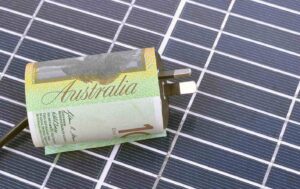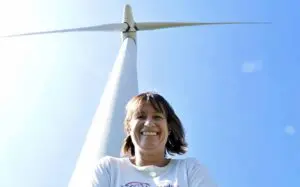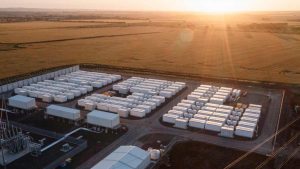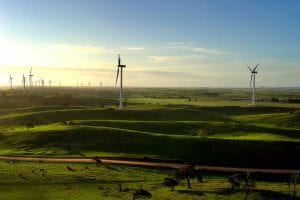Rooftop solar is grabbing a lot of headlines, and setting lots of records. It’s also eating the traditional feeding lots of the fossil fuel industry, and reshaping the way the grid is being managed. But it’s also presenting some interesting challenges.
Last week, Australian Energy Market Operator chief Daniel Westerman called emergency rooftop solar switch-off mechanisms to be implemented across the country’s main grid, to better control “more than seven Eraring power stations” worth of consumer installed PV.
Westerman points out that Australian households and businesses have collectively installed around 3.5 million solar systems, representing about 20GW of potential generation capacity.
“That’s more than seven Eraring power stations at full output, and capable of meeting almost half [48%] of our energy demand when the sun is shining at its brightest.
“And having so much generation that doesn’t respond to market signals or operational signals, can sometimes be a challenge,” he says.
So what is a solar switch-off mechanism, how does it work, where is it already being used in Australia, and where will it be rolled out next?
What is it and do we really need it?
The so-called solar switch-off or remote solar shut-down mechanism is a “last resort” measure devised by AEMO and electricity networks to ensure rooftop solar systems can be curtailed or remotely disconnected from the grid if needed.
Not surprisingly, there was considerable industry push-back against the concept when it was first introduced, with critics slamming it as regulatory overreach and a “blunt instrument” that would ultimately cost consumers.
In an IEEFA briefing note published in 2021, Gabrielle Kuiper and Steve Blume argued that market bodies and governments should focus on accelerating the deployment of smart, dynamic technologies to modernise the grid rather than imposing crude cut-off mechanisms that reach in behind the meter and take control from households.
But AEMO has not backed down. It says that while the electricity grid can currently handle high levels of rooftop solar generation most of the time, on rare occasions the combination of certain grid stresses with high rooftop solar generation will inevitably threaten the secure and reliable supply of electricity.
“When rooftop solar generation is high, the need for grid-scale supply naturally becomes extremely low, which displaces grid generators,” AEMO says here.
“At present, these generators provide a range of essential system services, including frequency control, system strength, voltage management, inertia, and so on.
“In periods of very low operational demand, these services need to be sourced from elsewhere or, if that isn’t possible, AEMO must intervene to keep the grid in a secure operating state.
“In these periods there is also a risk of rooftop solar unexpectedly disconnecting in large volumes at the same time as a large generator, also risking system security because we don’t have enough load in reserve to cover the loss.”
How it works
When this sort of critical market imbalance happens, or looks like happening, the market operator can now send signals to the market to remotely switch off or “curtail” groups of rooftop solar systems on some parts of the grid to help keep the lights on.
On the network side, AEMO does this via a three-step notification process:
Notice 1 – Advance notice of possible event to manage the risk of rooftop solar PV disconnecting at the same time as a large power station and/or minimum system load
AEMO says the first notification communicates to the electricity market ahead of, and during, any event that may result in rooftop solar PV being prevented from generating. This notice will generally be issued one day in advance where challenging operating conditions are forecast to give the market time to prepare and respond, but could be issued quite quickly if unexpected conditions arise.
Notice 2 – Confirm operational actions taken
This notice signals that the market hasn’t been able to take sufficient action to clear the risk and that AEMO is
taking available steps to maintain system security, such as turning down large power plants.
Notice 3 – Notifies that curtailment of rooftop solar PV is happening
This notice signals that some rooftop solar PV is being prevented from generating as a last resort to protect system security and reduce risks, such as a state-wide black-out, says AEMO.
On the customer side, the orders are sent via the networks – and sometimes via another intermediary – to the rooftop solar system’s smart inverter (unless you’re in Queensland, but more on that below), which then responds by switching the system off or dialling its exports back.
As the WA government explains here, while generation from managed rooftop solar systems is turned down or off, grid power will continue to be supplied to these homes as normal.
The WA government also says: “Emergency solar management will be the last resort before entire suburbs with high volumes of solar exports lose power.
And “before households are impacted, all other tools will be exhausted, including turning off other large generators. Large generators are already subject to this type of management and will not be compensated when this occurs.”
Where is it being used?
So far, the South Australian, Western Australian, and Queensland governments have each implemented solar management programs that enable some rooftop solar systems to be switched off remotely in extreme conditions to protect grid stability.
In South Australia…
The first so-called “solar switch-off” rule was adopted in SA in late 2020.
The Smarter Homes Program aims to ensure the state’s incoming fleet of new rooftop solar systems can “ride through” grid faults, be subject to changing export limits, and switched off if needed.
To enable this, all rooftop solar systems installed in the state must choose from a list of government-approved, compliant inverters (see here) and system owners must have appointed a “relevant agent” (listed here) which is approved to remotely control these inverters, if ordered to do so by AEMO.
As well as being the first state to introduce the big solar button, South Australia was also the first state to hit that button, on 14 March 2021 affecting around 12,500 households in Adelaide.
It hit it again in November 2022, in response to a rare “islanding” of the state grid after heavy storms brought down at least one transmission tower and caused multiple transmission lines to trip.
Western Australia
From February last year (2022) all new and upgraded rooftop solar systems with inverters of 5kW or less have been required to be capable of being remotely managed in emergencies.
This affects customer connected to WA’s main grid – the South West Interconnected System – who are installing a new rooftop solar system inverter of 5kW or less; upgrading an existing rooftop solar system inverter of 5kW or less; or adding a battery, with the solar inverter remaining 5kW or less.
For these households, the solar system’s inverter must meet the requirements for management capability, the options for which should be explained to consumers by PV installers, the government says.
Queensland
From February this year, all new and some replacement solar systems with an aggregated capacity of 10kW and above are required to have a generation signalling device (GSD) fitted to allow the inverter to receive a signal to switch off.
The Sunshine State’s use of generation signalling devices, also referred to as “ripple control,” has been slammed by industry and peak bodies as outdated, reckless and likely to impose “significant extra costs” on consumers and installers – according to Ergon, each GSD typically costs around $90 each, plus installation.
The signal is sent to the GSD from Ergon Energy Network and Energex’s powerline signalling system, known as Audio Frequency Load Control (AFLC). For larger sites with multiple inverters, including embedded networks, installers have the option of using a GSD on each inverter or installing a single GSD connected to a Demand Response Controller.
The basic on-off device, used to manage system security on the state’s grid “for almost 70 years,” has in the past mostly been used to control load, such as hot water systems. The Clean Energy Council was among the critics of its application to rooftop solar, arguing modern inverter technology can do a much better job.
“The remote disconnect reconnect functionality has already been built by the industry for use in SA and WA. Queensland could simply be added to the platform,” the CEC has said.
Still, Queensland has forged ahead undeterred with its ripple control approach, with Ergon noting that the
chances of an ‘emergency event’ occurring remain “very low” and “may only occur once per year or less.”
Ergon also notes that the state’s “requirement to install a GSD will be reviewed after 12 months and take into account progress towards implementing dynamic control of inverters.”
Where is the solar switch-off headed next?
Victoria.
The state Labor government says an emergency backstop for new, upgrading and replacement rooftop solar systems less than or equal to 200kW (small and medium) will be introduced in July 2024.
“For these rooftop solar systems, this means the power you generate and feed into the grid can be remotely turned down or switched off in an emergency,” a fact sheet says.
The Victorian government doesn’t go into much detail on how this will work in the state, but what it does say suggests that the mechanism will be smart/dynamic inverter-based, as in South Australia and WA.
“With an emergency backstop, network service providers must be able to remotely turn down or switch off rooftop solar systems during an energy supply emergency to avoid blackouts,” it says.
“The emergency backstop mechanism will only be used when required by the Australian Electricity Market Operator (AEMO) and only in rare emergencies when solar exports are too high to be safely managed. It will help to avoid blackouts and make sure that Victorians can continue to use electricity.”
In terms of cost, the Victoria fact sheet says “it is expected to cost solar households between $4 and $7 in lost feed-in tariffs per year.”
And in the longer-term?
As the grid and smart distributed energy technology evolves, the need to arbitrarily switch off swathes of rooftop solar will become redundant, or at least very rare.
Instead, ever smarter inverters, home battery storage, electric vehicles, dynamic operating envelopes, virtual power plants and other smart energy management solutions will help households to optimise rooftop solar consumption and generation and make it a more predictable and flexible resource for the market operator.
As the WA government puts it, emergency solar management is a “stepping stone” to a much smarter and better orchestrated grid.

AEMO says: “In future, where the majority of the power system may be supplied by consumer resources at certain times, it will be necessary for these resources to participate in active market frameworks, to deliver much of the essential services required by the grid.
“New consumer-focused markets are being designed to enable consumers to harness the full value of their energy devices, such as rooftop solar.
“These markets will directly benefit consumers and all energy users with a more reliable, secure and affordable power supply, and enable everyone to continue installing rooftop solar.”
Hooray!










